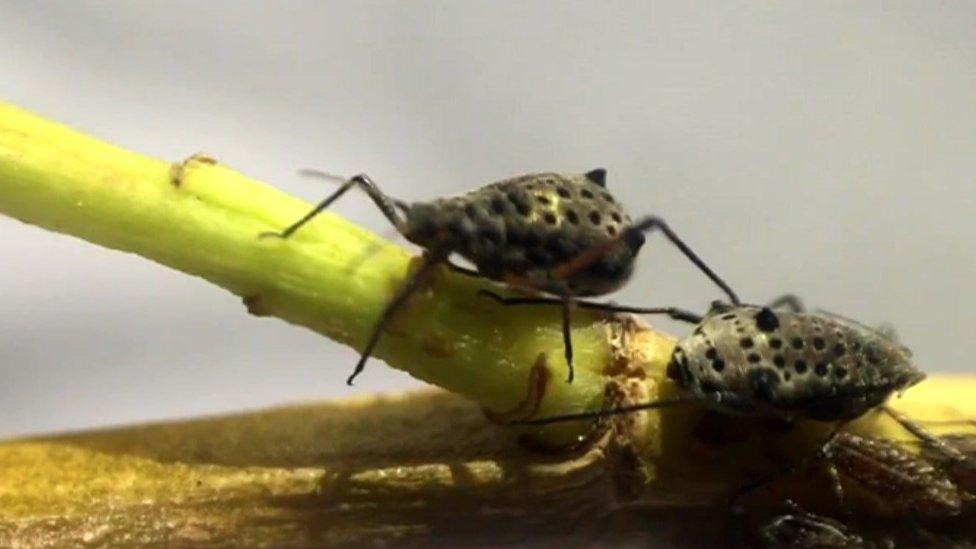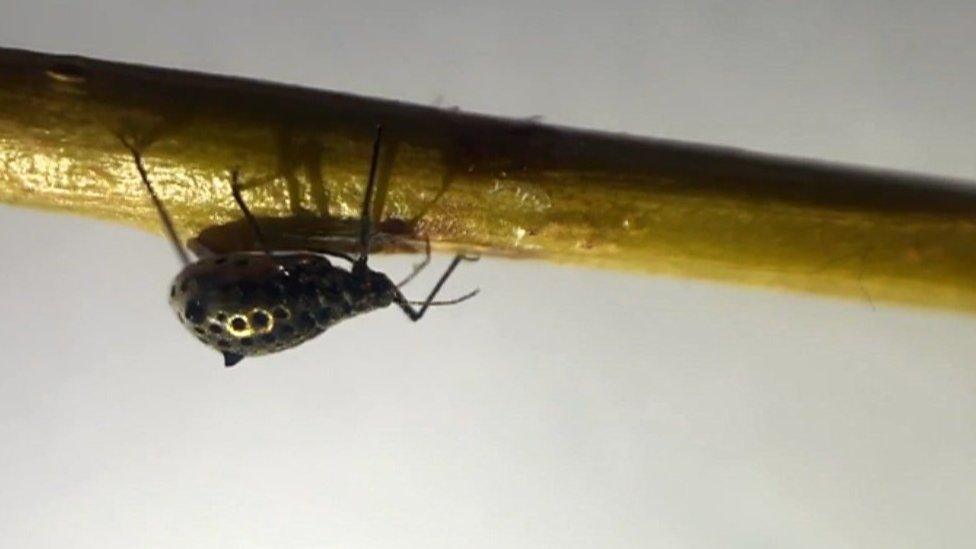Can you solve an insect mystery that scientists can't?
- Published
University researchers have spent 15 years trying to answer aphid queries
One of the great things about my job is you discover just how little we actually know about the natural world. And because as humans we tend to focus on the furry and (to a lesser extent) feathered bits of that world, most of the really big gaps in our knowledge are to do with insects.
Take the giant willow aphid or Tuberolachnus salignus. As you can see, it's a pretty large aphid with a shark-style fin on its back.
It's a bit of a brute.
Where other aphids are a meal for a passing ladybird, the giant willow aphid tends to beat them up.
It also doesn't bother sucking sap from the flimsy willow leaves, it just plunges its mouth parts straight into the willow branch.
Farmed by ants

The giant willow aphid on the right has stuck its mouth parts deep into the willow branch to drink the sap
It produces a huge amount of sugar as a by-product of its hungry sap-sucking for the nitrogen it needs - about four times its body weight every day.
That's equivalent to me leaving a huge amount of water containing more than 300 bags of sugar when I go to the toilet.
That sweet waste often attracts the attention of ants who will farm the willow aphids and take the sugar they produce.
Interestingly, scientists at Shropshire's Harper Adams University discovered the ants will even move aphids to other willow trees to produce more sugar for the ant colony.
Indeed, the ants seem to know which willows will produce the best sap for the aphids and so the best sugar crop for them.
But all this isn't what makes the giant willow aphid so interesting to the team at Harper Adams.
After 15 years of studying them and two PhD students having a really close look, we still don't know what the shark fin is for - and we also don't know where the aphids disappear to every November.
Mystery disappearance

This giant willow aphid is pictured clinging upside down to a willow branch in the lab. Notice the 'shark fin' on the back.
Wherever they disappear to in winter, it's about this time of year that the aphids re-emerge and start to appear on willow trees.
They'll happily feed for the next six months before quietly disappearing again.
It seems incredible we have such a big gap in our knowledge for an insect you may well come across in your garden or walking the dog by a river.
There's a possibility it migrates to another plant in November and we haven't found it there yet; that's something other aphids do and there's a long history of biologists being confused by this behaviour.
Watch the willows

If you know a willow, keep an eye out for the giant willow aphid and, come November, watch it very carefully
It's also possible they may head down the willow tree and over-winter in the roots.
We just don't know. So you can help the scientists out.
If you know a willow, keep an eye out for the giant willow aphid and, come November, watch it very carefully.
Is it heading down the trunk of the tree, or is it even starting to develop wings?
The more data we have, the more chance we can solve the mystery of where these amazing aphids go.